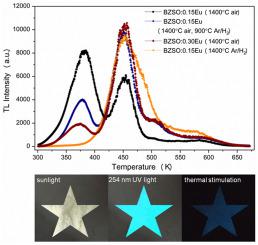当前位置:
X-MOL 学术
›
Opt. Mater.
›
论文详情
Our official English website, www.x-mol.net, welcomes your
feedback! (Note: you will need to create a separate account there.)
Introducing and studying origin of deep electron traps in Ba1-xZrSi3O9:xEu for optical data storage
Optical Materials ( IF 3.8 ) Pub Date : 2021-01-01 , DOI: 10.1016/j.optmat.2020.110617 Zhenzhen Zhou , Caiyan Wang , Mingxue Deng , Xiaoke Xu , Qian Liu
Optical Materials ( IF 3.8 ) Pub Date : 2021-01-01 , DOI: 10.1016/j.optmat.2020.110617 Zhenzhen Zhou , Caiyan Wang , Mingxue Deng , Xiaoke Xu , Qian Liu

|
Abstract Eu ions doped Ba1-xZrSi3O9:xEu materials are synthesized by solid state reaction method, facing optical data storage applications. The doping of Eu ions introduces deep electron traps at 0.90 eV below the conduction band minimum of Ba1-xZrSi3O9:xEu (1400 °C air). Moreover, the trap distribution is tunable, and there are only deep traps in sample Ba0·85ZrSi3O9:0.15Eu (1400 °C Ar/H2) with the disappearance of shallow traps. Deep traps can prevent information from loss, while the disappearance of shallow traps can eliminate interference to deep traps by avoiding redeployment of electrons between shallow and deep traps over time. Further, post-sintering in a reducing atmosphere after sintering in the air can increase the concentration of deep traps and deepen the color of samples, while post-sintering in the air after sintering in a reducing atmosphere can obviously decrease the concentration of deep traps and the color of samples return to white from yellow. Experimental results indicate that the deep traps in samples Ba1-xZrSi3O9:xEu should originate from oxygen vacancy defects, which also serve as color centers. First principles calculations show that VO1 oxygen vacancy defects introduce obvious defect energy levels below the conduction band minimum of BaZrSi3O9-VO1, which further illustrate the deep traps should originate from VO1 oxygen vacancy defects located at the connection of layer to layer in layered matrix. Ba1-xZrSi3O9:xEu materials with deep electron traps are good candidates for optical data storage.
中文翻译:

用于光学数据存储的 Ba1-xZrSi3O9:xEu 深电子陷阱起源的介绍和研究
摘要 Eu离子掺杂Ba1-xZrSi3O9:xEu材料采用固态反应法合成,面向光学数据存储应用。Eu 离子的掺杂在 Ba1-xZrSi3O9:xEu(1400 °C 空气)导带最小值以下 0.90 eV 处引入了深电子陷阱。此外,陷阱分布是可调的,样品 Ba0·85ZrSi3O9:0.15Eu (1400 °C Ar/H2) 中只有深陷阱,浅陷阱消失。深陷阱可以防止信息丢失,而浅陷阱的消失可以通过避免随着时间的推移在浅陷阱和深陷阱之间重新部署电子来消除对深陷阱的干扰。此外,在空气中烧结后在还原气氛中进行后烧结可以增加深陷阱的浓度并加深样品的颜色,而在还原气氛中烧结后在空气中进行后烧结,可以明显降低深陷阱的浓度,使样品颜色由黄变白。实验结果表明,样品 Ba1-xZrSi3O9:xEu 中的深陷阱应该源自氧空位缺陷,氧空位缺陷也作为色心。第一性原理计算表明,VO1 氧空位缺陷在 BaZrSi3O9-VO1 导带最小值以下引入了明显的缺陷能级,这进一步说明深陷阱应该源自位于层状矩阵中层与层连接处的 VO1 氧空位缺陷。Ba1-xZrSi3O9:xEu 具有深电子陷阱的材料是光学数据存储的理想选择。
更新日期:2021-01-01
中文翻译:

用于光学数据存储的 Ba1-xZrSi3O9:xEu 深电子陷阱起源的介绍和研究
摘要 Eu离子掺杂Ba1-xZrSi3O9:xEu材料采用固态反应法合成,面向光学数据存储应用。Eu 离子的掺杂在 Ba1-xZrSi3O9:xEu(1400 °C 空气)导带最小值以下 0.90 eV 处引入了深电子陷阱。此外,陷阱分布是可调的,样品 Ba0·85ZrSi3O9:0.15Eu (1400 °C Ar/H2) 中只有深陷阱,浅陷阱消失。深陷阱可以防止信息丢失,而浅陷阱的消失可以通过避免随着时间的推移在浅陷阱和深陷阱之间重新部署电子来消除对深陷阱的干扰。此外,在空气中烧结后在还原气氛中进行后烧结可以增加深陷阱的浓度并加深样品的颜色,而在还原气氛中烧结后在空气中进行后烧结,可以明显降低深陷阱的浓度,使样品颜色由黄变白。实验结果表明,样品 Ba1-xZrSi3O9:xEu 中的深陷阱应该源自氧空位缺陷,氧空位缺陷也作为色心。第一性原理计算表明,VO1 氧空位缺陷在 BaZrSi3O9-VO1 导带最小值以下引入了明显的缺陷能级,这进一步说明深陷阱应该源自位于层状矩阵中层与层连接处的 VO1 氧空位缺陷。Ba1-xZrSi3O9:xEu 具有深电子陷阱的材料是光学数据存储的理想选择。











































 京公网安备 11010802027423号
京公网安备 11010802027423号